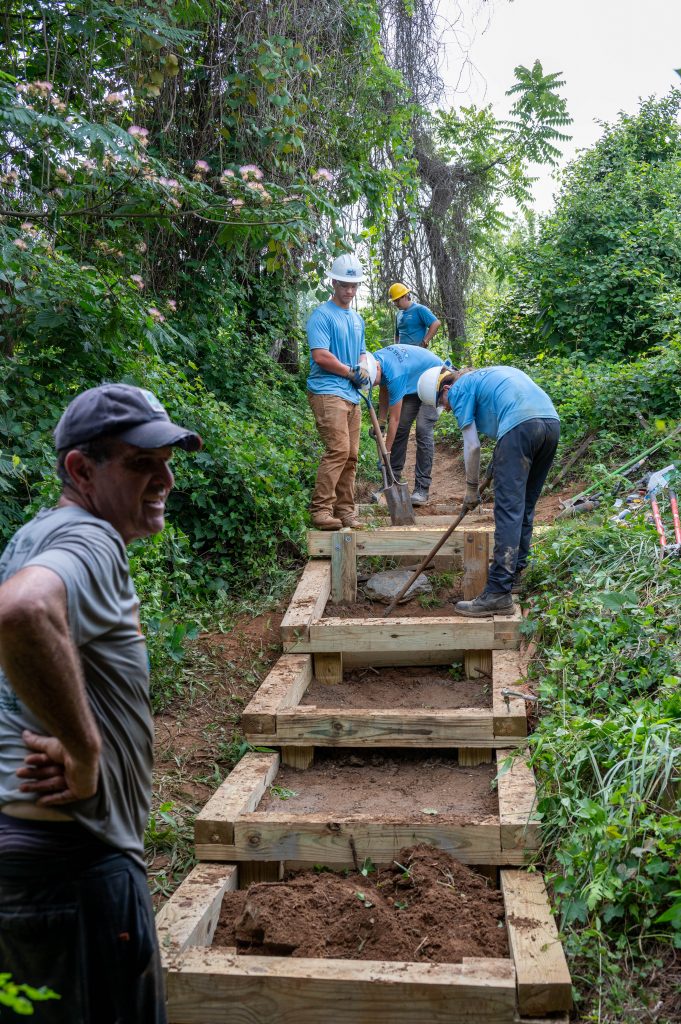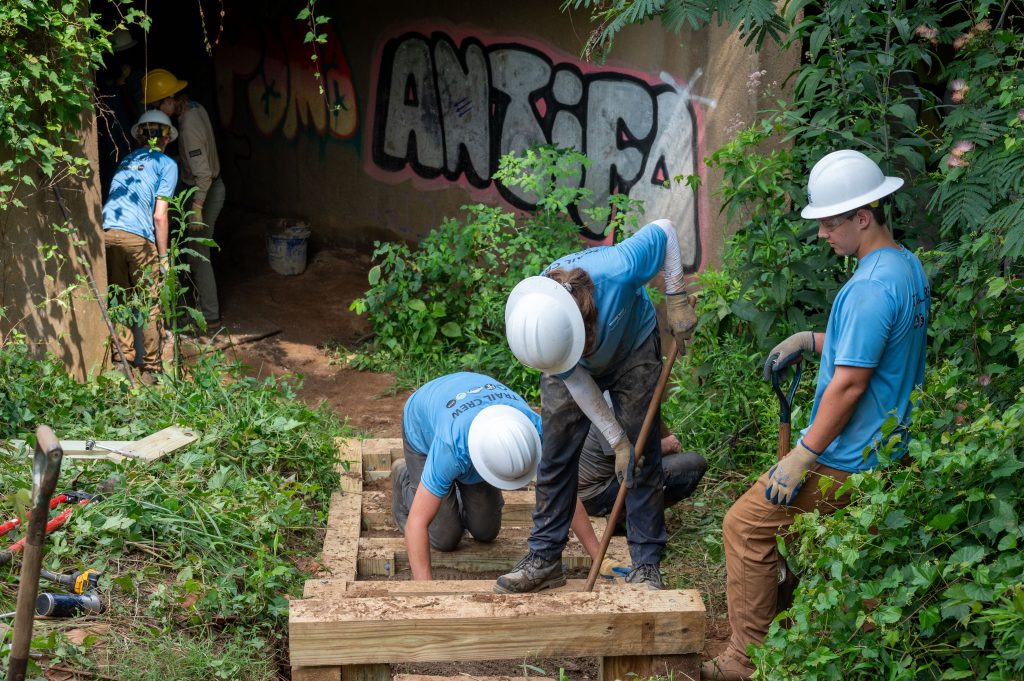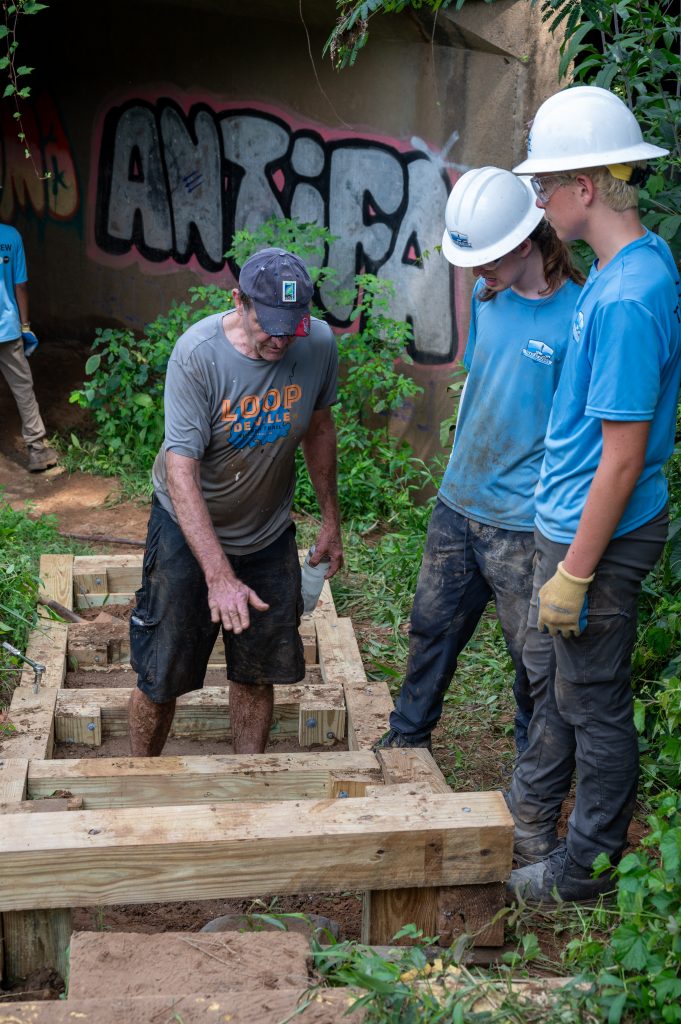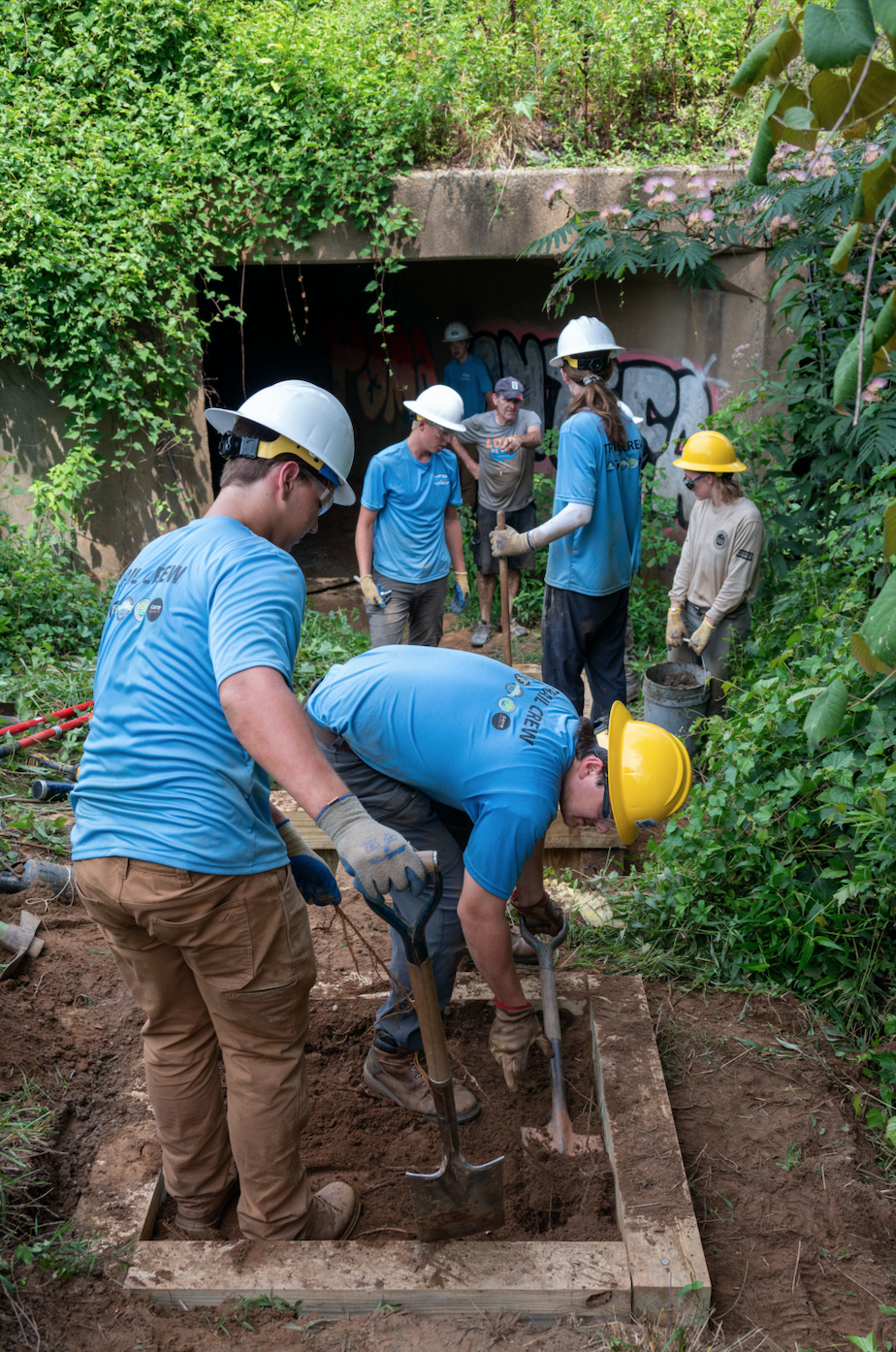On the last Monday in July, in the fields behind the Fifth Street Starbucks, a crew of sweaty high school kids is taking a mid-morning break, swigging energy water and snarfing down bags of chips (after working outside all morning, they need the salt). Their blue T-shirts say “Trailblazers.” And that’s what they are—pioneers in a pilot program to get local youth acquainted with the outdoors and maybe introduce them to careers in conservation. An added bonus: These kids are earning a paycheck while providing much-needed maintenance on the popular Rivanna Trail encircling Charlottesville.
The Trailblazers: Charlottesville to Shenandoah program is one of those genius ideas that seem obvious—once everyone has done the work to make it happen. But it took four local organizations, two city programs, a local retailer, and a national nonprofit working together to make the idea into a reality.
The lead organization on the Trailblazers program is the Shenandoah National Park Trust, which runs a trail maintenance program called the Shenandoah Youth Corps, designed to provide young people with work experience in conservation. The Appalachian Conservation Corps has partnered with SNPT on the Youth Corps program for the last six years, providing experienced adult leaders for the youth trail crews and handling logistics.

Tommy Safranek, a Rivanna Trails Foundation volunteer who had previous experience as a youth trail crew leader, had applied for a grant from outdoor retailer Public Lands in hopes of starting such a program here—right before the city hired him as its bike and pedestrian coordinator. Safranek is also on the board of the RTF, which is always looking for ways to get the community involved in both using and caring for the Trail—as is the Charlottesville Area Mountain Bike Club, whose members also use and help maintain the Trail.
“We’d been having conversations with Zach Foster [ACC’s executive director] about how to go about diversifying the Shenandoah Youth Corps, so that was fresh in my mind when I ran into Tommy Safranek one night while he was out walking his dog,” recalls Ethan Serr, SNPT’s corporate and foundations development manager. “We started talking about our different organizations and found a shared challenge in the need to diversify trail usage. He had mentioned that they were exploring the idea of a youth trail crew for the Rivanna Trail, which got me thinking about how we could collaborate as a means of developing a pipeline for more diverse participation in the Shenandoah Youth Corps. I pitched the idea to the Trust’s executive director and the director of partnerships, and they of course were interested and took the lead from there.”
Last August, SNPT and ACC met with RTF to discuss building a paid youth corps program in the Charlottesville area. SNPT was willing to act as lead, but the other organizations contributed as well, with added financial support from Safranek’s Public Lands grant and funding from the Virginia Outdoors Foundation.
It made sense that the adults managing the youth crew would be hired from the ACC staff. “We’re in charge of actual implementation,” explains Foster, “because we have [the Youth Corps] experience at managing the work. We handle the transportation, the risk management, and have the crew leaders who provide mentorship. But CAYIP was really the key because they can recruit the participants.”
CAYIP—the city’s Community Attention Youth Internship Program—finds local retailers and organizations willing to provide Charlottesville youth with paid summer internship programs that widen their experience and help them develop career skills. Latara Ragland, interim CAYIP coordinator, says, “We became highly interested and truly excited about the program. CAYIP is always looking for site partners that are conducive to mentoring young people while they receive a hands-on work experience. [Trailblazers] made it even more exciting because of the commitment and dedication all these agencies were already investing in our community and young people.”
This spring, CAYIP added Trailblazers to the youth internship recruitment efforts it runs every year in Charlottesville schools. Applicants for Trailblazers had to be city residents aged 16 to 18. Participants are expected to work up to 20 hours a week for the six-week session and will earn a performance-based stipend of up to $15 per hour (not to exceed $1,800). They are also expected to build a resume at the end of their internship.

Trailblazers team lead Emma Callan of ACC says the eight interns spent their first day in the field learning how to use the tools of trail maintenance. Each day starts with a “stretch-and-safety circle,” not just to get ready for hard physical work, but to reinforce safe practices “and remind everyone to stay hydrated.” After seven weeks of trail work, the program ends with an intensive three-day camping and trail maintenance project in Shenandoah National Park—a new experience for most of these young people.
On the day I visit, Callan and her colleague Jon Rice have a crew of five—Wes Swanson, Jamond Johnson, Eagan Matthews-Huba, Matthias Zimmerman, and Will Wright—working on installing a series of steps where the trail heads down into an underpass below Fifth Street between the Starbucks and the former Christian Aid property. (Other crew members Christian Martinez, Nava Khurgel, and Nick Brown are out today.)
“Some of these kids are active outdoors—they do sports, some have used the trail,” says Callan. “But they are mostly trail newbies in terms of manual labor.” I arrive during their late morning break (hence the drinks and snacks); the boys are sweaty but good-humored and put their hard hats back on cheerfully when work resumes.
Overseeing construction is Tim Pare, a retired engineer and longtime RTF volunteer. “The trail was being eroded here,” he points out. “This is low ground that gets flooded and gravel would wash away, so we’re cutting in steps, framing them out with lumber, and filling in with a combination of gravel and concrete called lean mix.” (The trail intersects a section of sewage lines at this point, so the Albemarle County Service Authority donated the materials for these steps.)

In comments provided by ACC, Swanson said he found out about the program through his school’s career fair. “It’s really cool learning how the trails are designed and learning how to make it the right angle so the water flows off it in the right way. It’s also really fun using all the machinery. I definitely want to find a way to work in conservation after this experience. Maybe I could do it every summer during college. I would love to have a career related to this.”
Similarly, Zimmerman, a CHS senior, said, “I’ve always been around the Rivanna River and live right near the trail, so it’s awesome to be making this area even better. I’m learning more skills so I can really use what I have learned to better my community. I was definitely thinking about going into forestry as a career—or something with outdoor nonprofits in the future.”
As this year’s pilot program is wrapping up, the consensus is that Trailblazers has been a success all around. “We are so proud of the interns—all eight successfully completed this session,” says Ragland. “Their feedback has been consistent: They have truly enjoyed the experience.” In fact, she notes, “We had more students interested in the program than we could accept this year, and we hope this interest grows in the future as more teens learn about it.”
“The crew is putting in really solid work, and the kids are getting real skills working with RTF and CAMBC,” says Lauren Croissant, ACC youth program coordinator. That’s good news for ACC and SNPT as well, since these organizations hope the Trailblazers internship will lead a more diverse group of young people into programs like the Youth Corps and help the Park build relationships and encourage interaction with surrounding communities. In fact, Serr says SNPT has had interest in programs similar to the one in Charlottesville from Richmond, Harrisonburg, and Washington, D.C.

In a Trailblazers press release, Bobby Casteen, a CAMBC board member, calls Trailblazers an important initiative “because it promotes collaboration between community organizations to create change, and it can influence youth to see the value in community engagement and service.”
Safranek sees awareness of the city’s natural resources as another of the key goals of the Trailblazers program. “As the city’s bike and pedestrian coordinator, my job is to get more folks in our community walking and biking,” he says. “Sometimes that means building more sidewalks and bike paths, but this program allows our youth to discover the amazing trail resources that we have right here in Charlottesville. So, my hope is that they not only make our community more friendly to walk and bike, but they also now choose to bike or walk next time they need to get around town.”
For Callan, one of the rewards for the Trailblazers interns is the sense of accomplishment and community pride it gives them. “Once these steps are done—or any of our projects they worked on—they can come back to the trail and show their families and friends, ‘Hey look, I built that!’”
